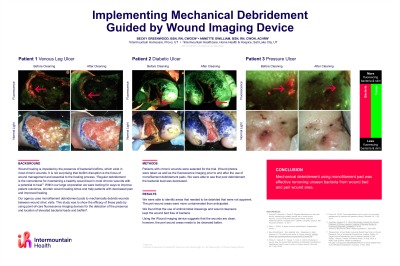Case Series/Study
(CS-060) Implementing Mechanical Debridement Guided by Wound Imaging Device
Friday, May 2, 2025
7:45 PM - 8:45 PM East Coast USA Time

Becky Greenwood, BSN, RN, CWOCN – Wound and Ostomy Nurse Coordinator, Homecare Education, Intermountain Health
Introduction: Clinical Problem: Wound healing has been shown to be impeded by the presence of bacterial biofilms which exist in most chronic wounds. It is not surprising that biofilm disruption is the focus of wound management and essential to the healing process. “Regular debridement is the cornerstone for maintaining a healthy wound bed in most chronic wounds with a potential to heal.” 1
Past management: Within our large corporation we were looking for ways to improve patient outcomes, shorten wound healing times and help patients with decreased pain and improved healing. Advanced wound care was being used but healing was slow.
Methods: Our agency uses monofilament debridement pads to mechanically debride wounds between wound clinic visits. This quality improvement project looked at the efficacy of these pads by using point-of-care fluorescence imaging devices for the detection of the presence and location of elevated bacterial loads and biofilm2.
Results: Patient outcomes: Several patients with chronic wounds were selected for the trial. We highlight three for our series. Wound photos and fluorescence imaging were taken prior to cleansing the wound. Surprisingly, the results of the imaging showed that the periwound was more contaminated with bacteria than the wound bed. The wounds and periwound areas were then cleansed using the monofilament debridement pads and the same imaging repeated. The results showed that post cleansing with the monofilament pads the bacterial load was significantly decreased.
Discussion:
Conclusion: “Optimal wound-bed preparation consists of regular debridement to remove devitalized tissues, reduce bacterial load, and to establish an environment that promotes healing”3. However, if the periwound skin is contaminated this will also slow healing. With these results in hand, our providers order monofilament debridement between visits to keep the wound and periwound skin as free as possible from bacteria to promote improved healing rates.
Past management: Within our large corporation we were looking for ways to improve patient outcomes, shorten wound healing times and help patients with decreased pain and improved healing. Advanced wound care was being used but healing was slow.
Methods: Our agency uses monofilament debridement pads to mechanically debride wounds between wound clinic visits. This quality improvement project looked at the efficacy of these pads by using point-of-care fluorescence imaging devices for the detection of the presence and location of elevated bacterial loads and biofilm2.
Results: Patient outcomes: Several patients with chronic wounds were selected for the trial. We highlight three for our series. Wound photos and fluorescence imaging were taken prior to cleansing the wound. Surprisingly, the results of the imaging showed that the periwound was more contaminated with bacteria than the wound bed. The wounds and periwound areas were then cleansed using the monofilament debridement pads and the same imaging repeated. The results showed that post cleansing with the monofilament pads the bacterial load was significantly decreased.
Discussion:
Conclusion: “Optimal wound-bed preparation consists of regular debridement to remove devitalized tissues, reduce bacterial load, and to establish an environment that promotes healing”3. However, if the periwound skin is contaminated this will also slow healing. With these results in hand, our providers order monofilament debridement between visits to keep the wound and periwound skin as free as possible from bacteria to promote improved healing rates.

.jpg)